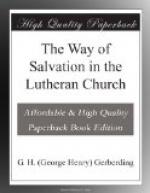Again we ask, is this the teaching of the Word? The very same proofs that convince us that the divine Word does not teach Transubstantiation, also convince us that it does not teach Consubstantiation. The simple fact that the earthly elements are called bread and the fruit of the vine, before, during and after consecration, satisfies us that they remain plain, simple bread and wine, without physical change or admixture. Consubstantiation is not the teaching of the Word; neither is it, nor has it ever been, the teaching of the Lutheran Church. It often has been, and is still called the Lutheran doctrine of the Lord’s Supper, but it is found in none of her confessions. It was never taught by a single recognized theologian of our Church. One and all, they have repudiated it and repudiate it still. The question then is still unanswered What is the doctrine of the divine Word?
There are many who have a ready and easy answer as to this doctrine. They say it is only a Church ceremony, one of the old, solemn rites by which Church members are distinguished from outsiders. There is indeed no special significance or Grace connected with it. There is really nothing in it but bread and wine. There is no presence of Christ at all in this sacrament in any way different from His general presence. The bread represents or signifies, is a sign, or symbol, or emblem of Christ’s body, and the wine of His blood. The communicant receives nothing but bread and wine, and while he partakes of these he remembers Christ’s sufferings and death. Whatever special benefit he is to derive from this sacrament he must first put into it, by bringing to it pious thoughts, good feelings, deep emotions, tender memories, and a faith that swings itself aloft and holds communion with Christ far off in heaven.
This is about the current, popular view of this subject as held and taught in nearly all the Protestant Churches of to-day, outside of the Lutheran Church. As a natural consequence of this superficial view, the whole matter is treated very lightly. There is little, if any, solemn, searching preparation. In many places there is no formal consecration of the elements. The table is thrown open to any one who desires to commune. There are no regulations, no guards, no disciplinary tests, connected with it. Even unbaptized persons, and persons who have never made a public profession of faith, are often permitted to commune. But we digress.
We return to the question: Is the view just noticed in harmony with and based on the Word? Let us see. If there is nothing on the altar but bread and wine, why does Christ say, “This is My body ... My blood?” Why not say, This is bread, this is wine? If Christ wanted us to understand that the bread and wine merely represent or are emblems of His body and blood, why did He not say so? Did He not know how to use language? Did He use dark or misleading words in His last Will




